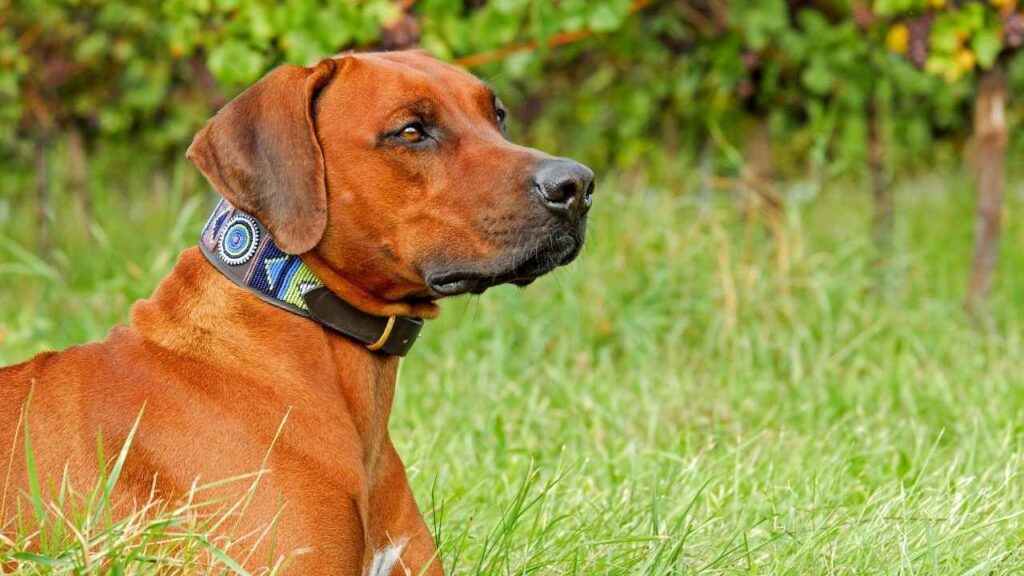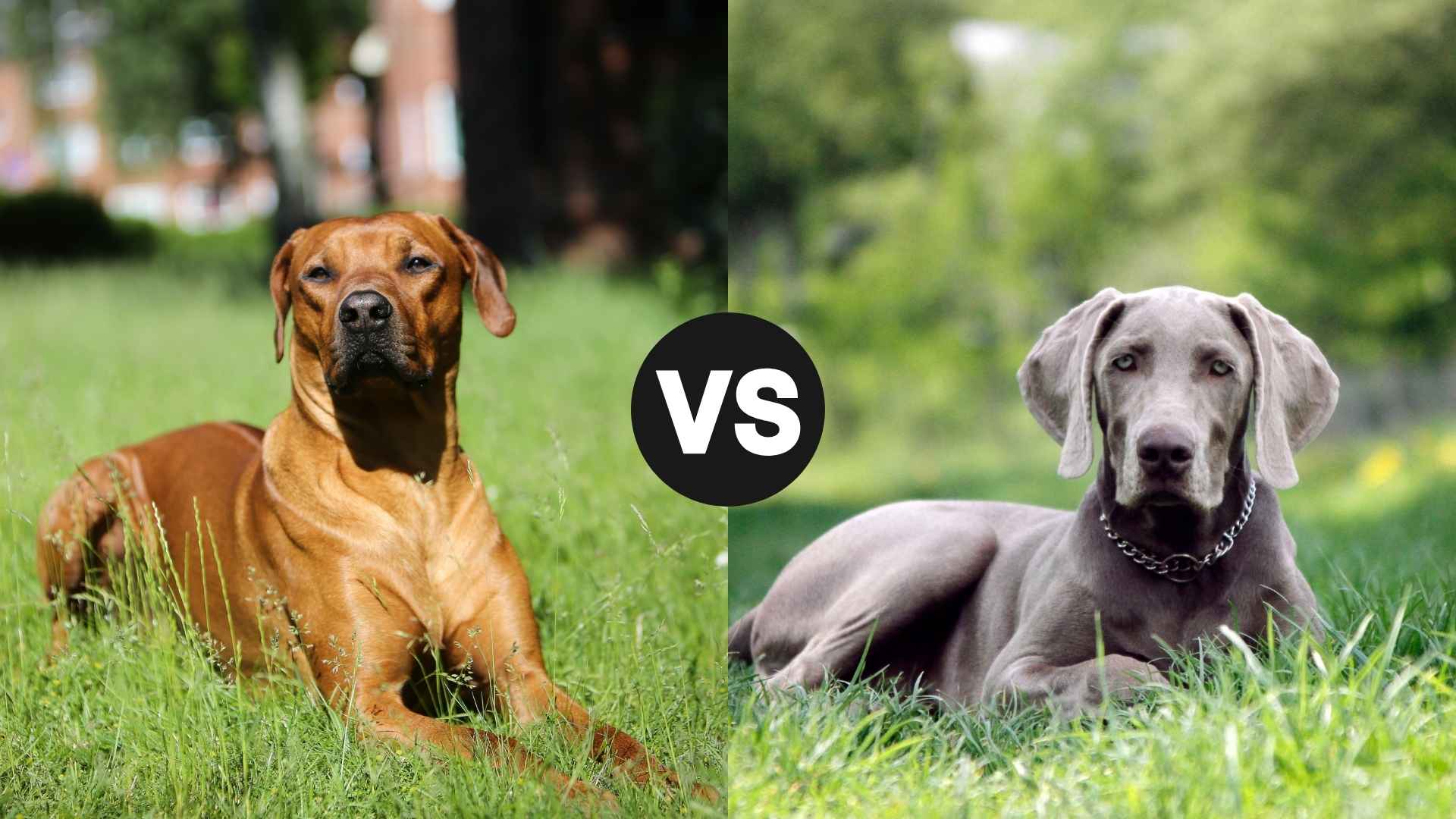When it comes to dog breeds that look like they were born to star in an action movie, the Rhodesian Ridgeback vs the Weimaraner are top contenders. The Ridgeback has a literal ridge of hair running down its back. The Weimaraner? It has an impressive jawline with a silver coat.
With over 68 million U.S. households owning dogs, according to APPA, breed confusion is real. This blog unpacks quirks, perks, and ‘wait, what?’ moments of both breeds. Let’s sniff out!
Rhodesian Ridgeback vs. Weimaraner
Both dog breeds are stunning, intelligent, loyal, and occasionally hilarious. So, who wins the Rhodesian Ridgeback vs Weimaraner face-off? Let’s find out with this in-depth comparison guide.
It is important to understand which dog suits your lifestyle and if they can survive in apartment living. Moreover, if you have kids at home, it is crucial to know which one is affectionate with kids.
From size differences, food needs, health problems, to trainability, we have covered it all. So you can be confident when making a decision after reading this blog!
Size and Weight Differences
If dogs were bodybuilders, then the Rhodesian Ridgeback would be that intimidating gym guy with veins popping. And The Weimaraner? Lean, long-legged, and built like a cross-country runner who never skips his protein shake.
Rhodesian Ridgeback
Height: 24 to 27 inches at the shoulder
Weight: 70 to 85 pounds
Build: Muscular, broad-chested, and strong
Known for: A ridge of hair that runs backward down the spine, like a stylish natural mohawk
Weimaraner
Height: 23 to 27 inches at the shoulder
Weight: 55 to 90 pounds (they can be heavyweights too!)
Build: Sleek, athletic, and lean, think runway model meets Olympic athlete
Known for: Shimmery silver-gray coat and hypnotic eyes
Fun Fact
Both breeds can knock over your coffee table in a single tail wag. But while the Rhodesian Ridgeback is more dense and rugged, the Weimaraner is more agile and lean. Think Thor vs Legolas!
Temperament and Personality Traits Comparison
You want loyalty, sass, and a little drama? Count on these dog breeds! Ridgebacks are the strong, silent type who might not fetch your ball but will guard your house. While Weimaraners are social butterflies with a love for speed, and affectionate cuddles!

Rhodesian Ridgeback
Calm but courageous
Aloof with strangers, loves their family
Independent thinker (Stubborn as a mule)
Protective instincts = great watchdogs
Weimaraner
Goofy, people-oriented, a total Velcro dog
High energy, like they drank three espressos
Love being the center of attention
Can be prone to separation anxiety (seriously, don’t leave them alone for too long)
Who Wins?
Depends. Want a dignified bodyguard who tolerates your lame jokes? Go Rhodesian Ridgeback. Prefer a clingy comedian who loves chaos? Say hello to the Weimaraner.
Trainability and Intelligence Evaluation
Training these dogs is like dating. One is hot but emotionally distant. The other is needy but eager to please.

Rhodesian Ridgeback
Smart but independent = selective listening
Requires patience and consistent training
Responds best to positive reinforcement
Can get easily bored, so keep training interesting
Weimaraner
Easy to train. Very intelligent and learns fast
High energy dogs, but get easily distracted (oh, there is a squirrel!)
Needs mental stimulation or they will create their own fun (Like eating your shoes or chewing your pillows)
Eager to please, especially with doggo treats
Training Tips
For Ridgeback: Easy to train at a young age, be firm but kind, and avoid harsh training methods.
For Weimaraners: Use games, challenges, and lots of praise.
Dietary Needs and Weight Management
Feeding these dogs is a pure science and a budget line. A warning: If any of these dogs feels hungry after eating, they must be a drama queen.

Rhodesian Ridgeback
Eats 2.5 to 4 cups of high-protein kibble every day
Prone to overeating and becoming obese if bored or under-exercised.
can develop food allergies, according to DVM360 (watch grains or chicken)
Needs lean protein for muscle maintenance
Weimaraner
Eats 2.5 to 3.5 cups of high-protein kibble every day
Faster metabolism and might need more food during high activity
Sensitive stomachs. Grain-free or limited-ingredients diets may help
Needs regular feeding times to avoid bloating
Watch for:
Bloating (gastric torsion in both dog breeds. Don’t feed right before or after intense activity.
Obesity, especially in Ridgebacks who chill like a Netflix pro when not exercised.
Bite Force and Jaw Characteristics
Time to talk teeth, because both of these dog breeds mean business when it comes to bite force. Both breeds have strong jaws but are not prone to biting unless scared, startled, or badly trained.

Rhodesian Ridgeback
Bite Force: estimated 230 to 300 PSI, according to Ridgeback Life.
Used as hunting dogs. Strong, broad jaws developed to track and distract lions (yup! real lions)
Not aggressive, but will bite if provoked or poorly trained
Teeth made for gripping, not playing patty-cake or fetching
Less likely to chew your furniture
Weimaraner
Bite Force: Slightly lower, falls between 200 to 250 PSI
Narrower jaw but still powerful
Originally bred for hunting large game
Loves carrying toys in their mouth like a golden retriever.
Will chew everything if bored, shoes, furniture, pillows…
Health Issues and Lifespan Expectations
They may both look like superheroes, but even superdogs have health quirks. Both dog breeds are generally healthy with the right diet and regular vet checks. But skip the drama and get pet insurance, your wallet will thank you!

Rhodesian Ridgeback
Lifespan: 10 to 12 years
Prone to: Hip dysplasia, dermoid sinus, and hypothyroidism
Tends to hide pain (stoic alert!)
Needs regular joint checks and heart screenings
Rhodesian Ridgebacks require less emergency visits, but genetic testing is important.
Weimaraner
Lifespan: 10 to 13 years
Prone to: Bloating, hip dysplasia, thyroid issues, separation anxiety
Sensitive to vaccines, watch initial shots. Regular vet checks are vital
May suffer from gastric issues if fed irregularly
Weimaraners require more preventative care and emotional support (yes, emotional too).
Allergies and Grooming Needs
Are these dogs low-maintenance or high fur-shedding divas? Let’s find out:

Rhodesian Ridgeback
Short, sleek coat, hence low grooming needs.
Weekly brushing is good enough
Minimal shedding (perk!)
Not a hypoallergenic dog, but better than fluffier breeds
Weimaraner
Also has a short coat, sheds more seasonally
Weekly brushing helps keep fur off your couch!
Needs occasional baths, especially after zoomies in the mud
Sensitive skin, so better to stick with mild shampoos
Allergy Alert: Neither breed is hypoallergenic, but Ridgebacks tend to be easier for allergy sufferers.
Grooming Costs: Low for both, generally, unless you count the price of lint rollers and emotional damage from fur-covered pants!
Fun Fact
Both breeds look like they walked out of a spa, even without any effort. It is not fair, honestly. (Jealousy at its Peak!)
Conclusion
So, who do you like more: Rhodesian Ridgeback vs Weimaraner? Well, it is less of a contest and more of a ‘choose your chaos’ situation.
Want a dignified, quiet protector who can handle lions (and toddlers)? Pick the Ridgeback. Prefer a bouncy, silver-coated drama queen who will follow you to the bathroom? The Weimaraner is your soulmate.
Whatever you choose, just remember: behind every great dog is a human buying treats in bulk! Still cannot decide? Flip a coin, just be ready for either to steal it!


